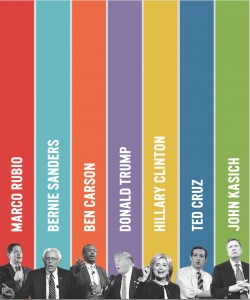Cobbers go against young voter trend and attend caucuses

The millennial vote was on the tips of political spectators’ tongues going into Super Tuesday. Concordia’s class of 2016 had only voted in one presidential election thus far but recognized the importance of the millennial vote this time around, and Cobbers showed up in force to the Minnesota caucuses.
The Atlantic defines millennials as those born between 1981 and 2000, and they represent 30.5 percent of eligible voters in this presidential election. The millennials are not projected to dominate this election, however, because older voters still have better turnout rates. But by 2020, there is a serious chance that millennials will be the largest voting group.
Cobber voters seemed to go against the poor attendance trend at the Tuesday night caucuses, according to senior Spencer Nelson, who said they made for some of the youngest voters.
“I heard over 200 [Concordia students] showed up to participate,” he said. “The majority of the voters at my location were under 30.”
Nelson credits this in part to the college-savvy location, but was encouraged by the participation all the same.
By 10:22 p.m., The Associated Press called the election with Rubio and Sanders as declared winners. Rubio grabbed 9 delegates with 36.8 percent of the vote, while Sanders received 59.8 percent of the votes at that time.
Senior Kylie Windecker had been looking forward to the caucuses for weeks.
“I caucused because I think it is so important to be responsibly engaged,” she said on Tuesday night.
Windecker is a self-proclaimed political enthusiast and works with Concordia’s Student Government Association. The lack of young voters showing up to primaries and caucuses in previous elections troubles Windecker.
“I think that we have a huge voter turnout issue with young people in the United States, and I didn’t want to be part of the problem,” she said.
Minn. DFL Chairman Ken Martin said earlier Tuesday evening that the state was seeing a huge turnout, and long lines were reported in Moorhead.
Both the MSUM and Moorhead locations ran out of ballots, citing a record turnout.
The caucus location at Moorhead High School was still signing in voters 15 minutes past the scheduled start time. Not long after registration closed, it was standing-room only in the auditorium.
Senior Austin Gerth credits Sanders’ candidacy for getting him to the caucus.
“I think if millennial voters turn out in force, they can have a massive impact on the election,” he said. “It’s such a powerful thing for a candidate to be able to bring in votes from people who don’t normally vote.”
Nelson agrees that millennial votes have the potential to greatly impact this race to the White House.
“Millennials are the key to this election,” he said. “They are the voice of the future, and if they choose to become involved, they will be the deciding factor in who leads our country.”
According to party spokesperson Katie Boyd, Minnesota Republicans reported a record turnout, with 79,000 participants recorded after only 70 percent of the votes were counted. That is 15,000 more than the record turnout of 2008.
Democrats reported heavy turnout as well, but had not cited specific numbers as of Tuesday evening.
Windecker would like to think that Cobbers are more involved than typical millennial voters, but admits that there are too many unknown factors to make that claim.
“This race has caught the attention of Cobbers more than ever, though,” she said.

